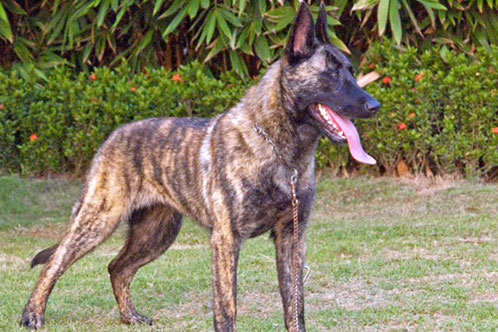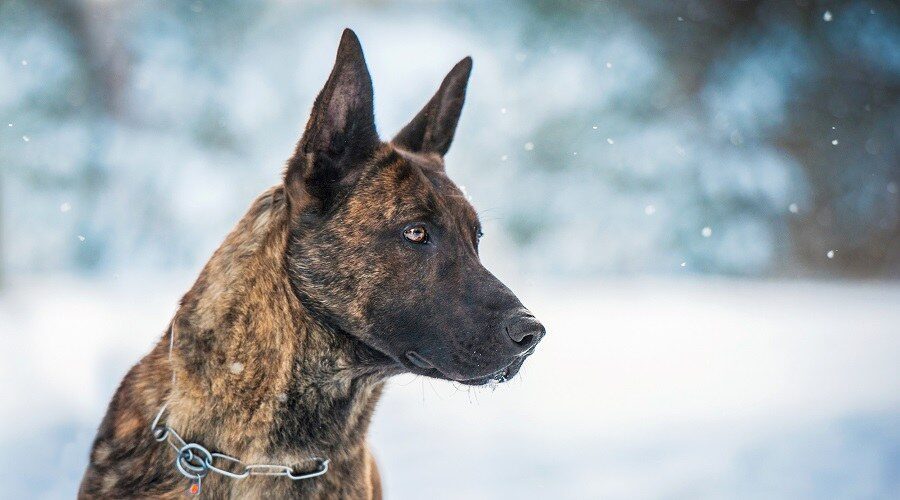German Shepherds are dogs that come in many colors; you can find up to 11 coat colors that kennel cubes accept. There are colors such as the blackbird, solid blue, and brindle that are considered fault coat colors, and unfortunately, they are becoming extinct.
Brindle is a color that is not standard in German Shepherds, and for many experts, this brindle gene is genetic instability. This is a very controversial topic and is the subject of much debate. Below you can learn a little more about this brindle coat of German Shepherds.
What Are Brindle Colored German Shepherds?
Contents

The brindle color of German Shepherds is a very specific coat color formed by alternating stripes. This brindle term is also known as tiger stripes. But depending on each dog’s genetics, the design can look different. There are times where two dogs with a brindle coat can look different.
The markings or stripes are usually darker than the undercoat of the coat. You may see a black streak on a tan or reddish base coat.
The Brindle German Shepherd will always be a great curiosity among traditional German Shepherd breeders. You should know that this coat is not part of the official AKC (American Kennel Club) breeds.
Four types of the brindle color
As mentioned above, four types of brindle color depend on the recessive and dominant genes. This disparity in brindle colors arises from a change in the base coat color gene.
-
Gray brindle German Shepherd
The brindle German Shepherd with a gray or silver base color can appear with very subtle or even absent pattern markings.
-
Brindle-Sable German Shepherd
The sable brindle German Shepherd has a brown or sable base color that looks like a more solid brindle. They may have darker fur on the back and head.
-
Brindle-Tan German Shepherd
This is a German grass with a darker or tan base color. It can have a coat that can range from black, tan to blue, from isabella to liver with brindle markings.
-
Black Brindle German Shepherd
This black brindle German Shepherd typically have recessive genes that can appear solid black, blue, liver, or Isabel. A black brindle German Shepherd appears to have light stripes on a dark coat base.
You may notice that 2 of the base colors arise from generic alterations of the eumelanin black gene. Simultaneously, 2 of the base colors come from genetic modifications from the red pheomelanin gene.
Where Does A Brindle Coat Color Pattern GSD Come From?

The brindle color of German Shepherds comes from the patrons of color generated by the GSDs. According to certain German Shepherd breeders, the first name certified as a German Shepherd was Horand Von Grafrath, previously known as Hektor Linkshrein, and he had 33 children. After extensive analysis and observations, they discovered that 2 of his sons had a brindle color.
Producing a brindle coat pattern requires complex genetic processes. It is more difficult to breed a dog with this brindle color and more difficult for people who consider brindle to be not a standard color than breed a dog with a basic or standard color such as red or black.
There are two types of central color genes that all canines inherit: pheomelanin and eumelanin. Pheomelanin controls primary red and red tones that can range from pale ivory, liver, brown to a burnished reddish. Pheomelanin is only responsible for controlling the color of the coat.
Eumelanin is in charge of controlling basic black and any color in that spectrum. It can be seen as pale blue, silver, and even absolute black. Eumelanin is also responsible for controlling the eyes, nose, and skin color.
How Different Are Brindle GSDs From Other German Shepherds?
Brindle-colored German Shepherd puppies are no different than other German Shepherds. They require many exercises and are very energetic dogs. They can inherit certain diseases or health problems as in the other standard GSDs in health.
They can have the sword inclined or straight, and they are very intelligent dogs like the German Shepherds of other accepted or standard colors. If you train them properly, care for them, and feed them the correct diet, you can have GSD brindle dogs that are ideal for work, intelligent, and very affectionate for the whole family.
Unfortunately, some clubs are not very fond of this type of brindle color because they consider it a failure. They regard brindle coat color as a faded color.
Where Do You Find Brindle Colored GSDs?
If you want to have a Brindle German Shepherd, you must understand these German Shepherds’ history. In this way, you can understand the development of this breed and why colors like the brindle are seriously affected.
Many German Shepherd history books, such as the German Shepherd Dog Club, decided to reduce the original German Shepherd colors. They did this because they were normalizing the GSD breed.
Looking for a GSD brindle can be difficult because colors like white, liver, blue blackbird, and brindle are the chosen eradication. To create a dog that bore a similar resemblance to the German Shepherd, the Dutch Shepherd was bred and came standard with a brindle color.
These are now available to German Shepherds at shelters or rescue centers. Brindle German Shepherds are generally abandoned by their owners wearing the standard GSD colors. Many breeders also leave them because they ruined a breeding presentation and produced an SD Brindle with health problems or physical health problems.
People who want to adopt Brindle German Shepherds should accept everything regarding this coat color. You should look for a breeder who is ethical so that you can find healthy tabby German Shepherds. It can be time-consuming and generally expensive work, but it will be in your best interest to have a coat color that is thought to be extinct.
How Much Does A Brindle GSD Cost?
A brindle German shepherd is expensive, but it will depend on the breeder and the demand for this color. The GSD Brindle can cost anywhere from $ 500 to $ 1,500 and can be increased if the brindle puppy comes with documents stating his pedigree, breeding history, line, and career title.
For many people, adoption should be the best way to get a pet; you can find adoptions for $ 50 and $ 500.




